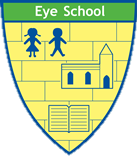Phonics
At Eye C of E Primary School, we place the highest importance on providing all children with a structured approach to learning to read from their very first days with us. In EYFS and KS1, we use a phonics programme called Sounds-Write. We started our Sounds-Write journey in September 2021, following our staff being trained in the programme throughout the 2020/21 academic year. It is a highly regarded linguistics programme that begins with sounds in the language and moves from sound to print. Children, in their daily phonics sessions, are taught conceptual knowledge and skills that enable them to say the sounds and read the words. The programme begins by teaching an ‘Initial Code’. During this phase, the children learn that:
- sounds can be represented by spellings with one letter
- that some spellings are written with a double consonant
- some spellings are written with two different letters
Once the children are confident with applying this understanding in their reading and spelling, they move onto the ‘Extended Code’ at the start of Year 1. During this phase, the children learn:
- a spelling can represent more than one sound
- the most common sounds represented by the target spelling
- how to manipulate alternative sounds in and out of words
The Extended Code lasts throughout Year 1 and Year 2 and the skills they learn will continue to be applied in their reading and spelling well beyond this time. Throughout the programme, close links are made between reading and spelling.
Sounds-Write teaches children:
- Letters are symbols (spellings) that represent sounds.
- Each sound may be represented (spelled) by a 1, 2, 3 or 4-letter spelling.
- The same sound can be spelled in more than one way (goat, slow, note, toe, over).
- Many spellings represent more than one sound (ea in read and bread).
The following skills are taught throughout the Sounds-Write programme:
- Blending – the ability to push sounds together to build words (c-a-t = cat)
- Segmenting – the ability to pull apart the individual sounds in words (pig = p-i-g)
- Phoneme manipulation – the ability to insert sounds into words and delete sounds out of words. This skill is necessary to test out alternatives for spellings that represent more than one sound.
It is important to note that speed and accuracy need to be achieved for all three of the above skills in order for them to become automatic.
Saying the sounds precisely video - Sounds-Write Initial Code
When your children start to learn to read and write, we do not use letter names. We just say the sounds very precisely - like in this video.
Year 1 Phonics Screening
At the end of Year 1, all children have to undertake the Year 1 Phonics Screening. Working 1:1 with a familiar adult, children will read 40 words, some of which are real and some of which are pseudo (made up/'alien') words containing the 40+ phonemes they have learnt during their first two years in school. The pass mark is usually around 32 and children who do not reach this standard will receive extra phonics support in Year 2 and resit the screening at the end of the following year.
How can you support your child at home with their phonics?
- Read as much as possible with your child at home. Remember to fill in your child's reading record every time you read together.
- Download the Sounds-Write app on your iPad (if you have one) for your child to play on at home. More information can be found via the link here:
https://www.sounds-write.co.uk/page-82-app-for-ipad.aspx - Compete the Sounds-Write parents course which will help you to help your child take their first steps in reading and spelling; understand how to help your child build, write and read simple cvc (consonant, vowel, consonant) words; understand how to correct your child when they make a mistake in their reading or writing simple words and it will help you to have a basic understanding of how phonics works. You can sign up to the free course here:
https://www.udemy.com/course/help-your-child-to-read-and-write/ - Attend the Phonics Information Evening for parents in the Autumn term - more information to follow in book bags and via Scholarpack.
- Use letter sounds rather than letter names with your child at home. This will avoid confusion for them and will reinforce the learning being done at school.
- When listening to your child read, encourage them to have a go at unfamiliar words by encouraging them to: ''say the sounds and read the word.''
- Visit the Sounds-Write website for further information, support and resources: http://www.sounds-write.co.uk/
- If you have any questions regarding phonics or phonic teaching, please contact your child’s class teacher.
